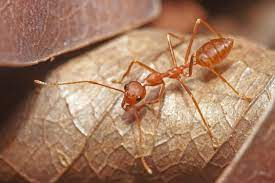Kai Chutney: Odisha | 04 Jul 2022
Why in News?
In Odisha, scientists are making a presentation for the Geographical Indications (GI) registry of Kai Chutney.
- The GI tag would help develop a structured hygiene protocol in the preparation of Kai Chutney for standard wider use. GI labels enhance the reputation and value of local products and support local businesses.
- In 2019, Odisha received the GI Tag for Odisha Rasagola.
What are the Weaver Ants?
- Kai (Red Weaver Ant) Ants, scientifically called Oecophylla smaragdina, are abundantly found in Mayurbhanj throughout the year. They construct nests with leaves of host trees.
- The nests are strong enough to withstand wind and are impermeable to water.
- Kai’s nests are usually elliptical in shape and range in size from a single small leaf folded and bound onto itself to large nests consisting of many leaves and which measure over half a meter in length.
- The family consists of three category members - workers, major workers and queens.
- Workers and major workers are mostly orange-colored.
- They feed on small insects and other invertebrates, their prey being mainly beetles, flies and hymenopterans.
- Kais are bio-control agents. They are aggressive and prey on most arthropods entering their territory.
- Due to their predatory habit, Kais are recognized as biological control agents in tropical crops as they are able to protect a variety of crops against many different insect pests. In this way, they are utilized indirectly as an alternative to the chemical insecticides.
What is Kai Chutney?
- About:
- The Kai Chutney is prepared from the Weaver ants and are popular in Odisha’s Mayurbhanj district among the people, mostly tribals.
- When required, leafy nests of ants are plucked from their host trees and collected in a bucket of water before sorting and separation from leaves and debris.
- Significance:
- It helps in getting rid of flu, common cold, whooping cough, to increase appetite, enhance vision and eyesight naturally.
- The tribal healers also prepare medicinal oil, which is used as baby oil and externally used to cure rheumatism, gout, ringworm and other skin diseases.
- So it is the only panacea for the tribes.
What is Geographical Indication Status?
- About:
- GI is an indication used to identify goods having special characteristics originating from a definite geographical territory.
- The Geographical Indications of Goods (Registration and Protection) Act, 1999 seeks to provide for the registration and better protection of geographical indications relating to goods in India.
- The Act is administered by the Controller General of Patents, Designs and TradeMarks- who is the Registrar of Geographical Indications.
- The Geographical Indications Registry is located at Chennai.
- The registration of a geographical indication is valid for a period of 10 years. It can be renewed from time to time for a further period of 10 years each.
- It is also a part of the World Trade Organisation’s Trade-Related Aspects of Intellectual Property Rights (TRIPS).
- Recent Examples: Judima Wine Rice (Assam), Tirur Vetilla (Kerala), Dindigul Lock and Kandangi Saree (Tamil Nadu), Odisha etc.
- Significance of GI Tag:
- Once the GI protection is granted, no other producer can misuse the name to market similar products. It also provides comfort to customers about the authenticity of that product.
- Having a GI tag for a product prevents unauthorised use of a registered Geographical Indication by others, boosts exports of Indian Geographical indications by providing legal protection and also enables seeking legal protection in other WTO (World Trade Organizations) member countries.
UPSC Civil Services Exam, Previous Year Questions (PYQ)
Q. Which of the following has/have been accorded ‘Geographical Indication’ status? (2015)
- Banaras Brocades and Sarees
- Rajasthani Daal-Bati-Churma
- Tirupathi Laddu
Select the correct answer using the code given below:
(a) 1 only
(b) 2 and 3 only
(c) 1 and 3 only
(d) 1, 2 and 3
Ans: (c)
Exp:
- A Geographical Indication (GI) is a sign used on products that have a specific geographical origin and possess qualities or a reputation that are due to that origin.
- India, as a member of the World Trade Organization (WTO), enacted the Geographical Indications of Goods (Registration and Protection) Act, 1999, which came into force with effect from 15th September 2003.
- Darjeeling tea was the first product in India to get a GI tag.
- Banaras Brocades and Sarees and Tirupathi Laddu have got GI tag while Rajathan’s Daal-Baati-Churma does not. Hence, 1 and 3 are correct. Therefore, option (c) is the correct answer

